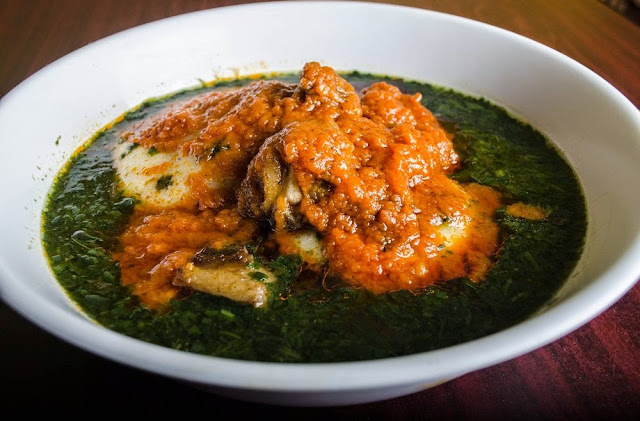Ghana is home to some of the most delicious dishes the continent has to offer and diverse cuisines in West Africa, boasting a rich tapestry of flavours, ingredients, and cooking techniques that reflect the country's cultural heritage and geographical diversity. In this blog, I will discuss the top five dishes that epitomize the essence of Ghanaian culture, exploring their ingredients and preparation methods.
Table of Content
- Fufu and Groundnut Soup
- Banku and Tilapia
- Ampesi
- Tuo Zaafi
- Gobe
- Conclusion
Fufu and Groundnut Soup
Fufu is a staple West African dish that is served with a wide variety of soups, sauces and stews. However, in my not-so-humble opinion, no culinary combination is as iconic as fufu and groundnut soup. Fufu is made from boiled and pounded starchy ingredients such as cassava, plantains, or yams, resulting in a smooth, dough-like consistency. On the other hand, Groundnut soup is crafted from a blend of roasted peanuts, tomatoes, onions, and spices, simmered to perfection to create a creamy and aromatic base. Together, fufu and groundnut soup form a beloved culinary duo that captures the essence of West African cuisine, offering a comforting and satisfying meal that is enjoyed across the region. The dish is enjoyed with a wide variety of proteins, including meats like chicken, beef, or goat, as well as seafood such as fish or shrimp, adding depth and richness to the already flavorful combination.
Banku and Tilapia
Banku is yet another classic Ghanaian dish that holds a special place in the hearts and palates of many. It is a fermented cornmeal and cassava dough that is cooked to a smooth, slightly sour consistency. Paired with grilled or fried tilapia fish, often seasoned with spices and herbs, banku forms a delicious and satisfying meal that is enjoyed throughout Ghana and beyond. The dish offers a delightful contrast of textures, with the soft and tangy banku complementing the crispy exterior and tender flesh of the tilapia. Often served with a side of zesty pepper sauce and fresh vegetables, banku and tilapia showcase the diverse flavors and culinary traditions of Ghanaian cuisine, making it a must-try for anyone seeking an authentic taste of West Africa.
Ampesi
Ampesi is a Ghanaian dish composed of boiled plantain and yam served with palava sauce. the latter dish is prepared by cooking cocoyam leaves in a palm oil base with a variety of spices and aromatics. This traditional Ghanaian meal offers a delightful fusion of flavors and textures, with the naturally sweet and starchy plantains and yams providing a hearty foundation for the rich and flavorful palava sauce. The cocoyam leaves, cooked to perfection in a fragrant palm oil base, infuse the dish with a unique earthy flavor, while the medley of spices and aromatics adds depth and complexity to the sauce. Ampesi is not only a delicious and satisfying meal but also a celebration of Ghanaian culinary heritage, showcasing the creativity and ingenuity of local cooks in transforming simple ingredients into a culinary masterpiece that delights the senses.
Tuo Zaafi
Hailing from the Northern region of Ghana, Tuo Zaafi is a traditional delicacy comprising a dense porridge accompanied by two distinct stews. The first stew boasts a rich tomato base, while the second incorporates flavorful jute leaves. This hearty dish is a testament to the culinary heritage of the region, with each component thoughtfully crafted to tantalize the taste buds and provide a satisfying dining experience. This dish boasts a rich array of textures and flavors, making it a true delight for the senses. The tender chunks of beef, succulent cowhide, flavorful tuna, and hearty tripe add depth and richness to the dish, complementing the velvety porridge and robust stews perfectly. Whether enjoyed as a comforting meal on a chilly evening or as a celebratory feast during festive occasions, Tuo Zaafi is a beloved culinary treasure that embodies the warmth, hospitality, and cultural richness of Northern Ghana.
Gobe
Gobe is an abbreviation for Gari, Oil, Beans and Eggs, which are the constituents of the dish. It is served with deep-fried ripe plantains which are often sliced thinly and fried until golden brown, offering a crispy and flavorful accompaniment to the hearty gobe. This popular Nigerian dish combines the richness of gari (cassava flakes) with the protein-packed goodness of beans and eggs, creating a satisfying and nourishing meal that is enjoyed by many. The deep-fried ripe plantains add a touch of sweetness and crunch to the dish, balancing out the savory flavors and textures. Generally eaten for breakfast, this delicious Ghanaian dish provides a hearty start to the day, offering a satisfying blend of flavors and textures that energize and nourish. Whether enjoyed for breakfast, lunch, or dinner, gobe is a versatile and comforting dish that is sure to satisfy hunger and tantalize the taste buds.
Conclusion
For the adventurous food enthusiast, Ghana offers an expansive array of dishes that tantalize the taste buds and showcase the rich diversity of West African cuisine. From the iconic flavors of fufu and banku to lesser-known delicacies like ampesi and tuo zaafi, Ghanaian cuisine is a treasure trove waiting to be explored. Whether you're navigating the bustling streets of Accra in search of street food delights or immersing yourself in the flavors of a traditional home-cooked meal, the culinary landscape of Ghana is a vibrant tapestry of flavors, aromas, and textures that never fails to captivate and delight. So, embark on a culinary adventure and savor the flavors of Ghana, where every dish tells a story and every meal is a celebration of culture and community.


.jpg)

Great piece
ReplyDeleteNice blog
ReplyDelete